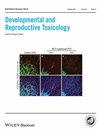药物致畸性筛选的发育毒理学分析平台。
Q Environmental Science
Birth defects research. Part B, Developmental and reproductive toxicology
Pub Date : 2016-01-05
DOI:10.1002/bdrb.21168
引用次数: 33
摘要
对药物化合物的主动安全性优化的需求日益增加,导致了体外发育毒理学分析的产生和/或改进。我们的实验室已经开发了三种体外发育毒理学试验来评估药物化合物的致畸性。这些试验包括小鼠分子胚胎干细胞试验(MESCA)、去角质斑马鱼胚胎培养(ZEC)试验和流线型大鼠全胚胎培养(rWEC)试验。单项分析的预测能力较好(73-82%)。然而,合并或分层检测是否能提高性能仍有待确定。73种化合物代表了广泛的药物靶点和化学成分,通过分析来评估,以产生优化性能的测试策略。MESCA和ZEC检测发现有两个局限性:化合物溶解度和具有H1受体或GABAnergic活性的化合物的频繁错误分类。流线型rWEC检测被发现是一种具有成本效益的独立检测方法,用于支持难溶性化合物和/或具有H1或GABAnergic活性的化合物。对于所有其他化合物,使用MESCA和ZEC检测的分层策略进一步优化了吞吐量、成本和最小化动物使用。分层策略提高了性能,达到88%的总体预测性,与频率分析达到的89%的总体预测性相当(最终的致畸分类是根据每个单独分析中最常见的致畸分类得出的)。此外,在测试集中有21种化合物被确定为人类致畸物或疑似致畸物,多重分析方法分别采用分层或频率筛选方法实现了95%和91%的正确分类。本文章由计算机程序翻译,如有差异,请以英文原文为准。
A Developmental Toxicology Assay Platform for Screening Teratogenic Liability of Pharmaceutical Compounds.
Increasing need for proactive safety optimization of pharmaceutical compounds has led to generation and/or refinement of in vitro developmental toxicology assays. Our laboratory has developed three in vitro developmental toxicology assays to assess teratogenic liability of pharmaceutical compounds. These assays included a mouse molecular embryonic stem cell assay (MESCA), a dechorionated zebrafish embryo culture (ZEC) assay, and a streamlined rat whole embryo culture (rWEC) assay. Individually, the assays presented good (73-82%) predictivity. However, it remains to be determined whether combining or tiering the assays could enhance performance. Seventy-three compounds representing a broad spectrum of pharmaceutical targets and chemistry were evaluated across the assays to generate testing strategies that optimized performance. The MESCA and ZEC assays were found to have two limitations: compound solubility and frequent misclassification of compounds with H1 receptor or GABAnergic activity. The streamlined rWEC assay was found to be a cost-effective stand-alone assay for supporting poorly soluble compounds and/or ones with H1 or GABAnergic activity. For all other compounds, a tiering strategy using the MESCA and ZEC assays additionally optimized throughput, cost, and minimized animal use. The tiered strategy resulted in improved performance achieving 88% overall predictivity and was comparable with 89% overall predictivity achieved with frequency analysis (final teratogenic classification made from most frequent teratogenic classification from each individual assay). Furthermore there were 21 compounds in the test set characterized as definitive or suspect human teratogens and the multiassay approach achieved 95 and 91% correct classification using the tiered or frequency screening approach, respectively.
求助全文
通过发布文献求助,成功后即可免费获取论文全文。
去求助
来源期刊
CiteScore
1.65
自引率
0.00%
发文量
0
审稿时长
>12 weeks
期刊介绍:
The purpose of this journal is to publish original contributions describing the toxicity of chemicals to developing organisms and the process of reproduction. The scope of the journal will inlcude: • toxicity of new chemical entities and biotechnology derived products to developing organismal systems; • toxicity of these and other xenobiotic agents to reproductive function; • multi-generation studies; • endocrine-mediated toxicity, particularly for endpoints that are relevant to development and reproduction; • novel protocols for evaluating developmental and reproductive toxicity; Part B: Developmental and Reproductive Toxicology , formerly published as Teratogenesis, Carcinogenesis and Mutagenesis

 求助内容:
求助内容: 应助结果提醒方式:
应助结果提醒方式:


